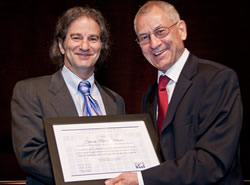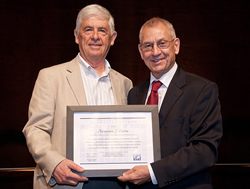CRD Researchers Receive Prizes, Present at ICIAM 2011
26 Win Awards, Give Presentations
July 20, 2011
By Jon Bashor
Contact: cscomms@lbl.gov

James Sethian, head of the Mathematics Group in the Computational Research Division is presented with the ICIAM Pioneer Prize by president of the International Council for Industrial and Applied Mathematics
Berkeley Lab researchers were prominent on the program of the the 7th International Congress on Industrial and Applied Mathematics (ICIAM 2011) held July 18–22, in Vancouver, B.C. Canada. In all, 26 LBNL staff members gave talks, presented papers and posters and organized technical sessions and two of Berkeley Lab’s leading mathematicians received special prizes for their research contributions.
ICIAM 2011 was sponsored by the International Council for Industrial and Applied Mathematics, a worldwide organization for professional applied mathematics societies, and for other societies with a significant interest in industrial or applied mathematics. The conference in Vancouver drew almost 2,700 attendees from 74 countries around the world.
Alexandre Chorin of the CRD Mathematics Group received the 2011 ICIAM Lagrange Prize for his fundamental and original contributions to applied mathematics, fluid mechanics, statistical mechanics, and turbulence modeling. The Lagrange Prize provides international recognition to mathematicians who have made an exceptional contribution to applied mathematics throughout their career.
Mathematics Group Lead and UC Berkeley professor James Sethian was presented the ICIAM Pioneer Prize “for his fundamental methods and algorithms that have had a large impact in imaging and shape recovery in medicine, geophysics and tomography, and drop dynamics in inkjets.” The Pioneer Prize recognizes pioneering work introducing applied mathematical methods and scientific computing techniques to an industrial problem area or a new scientific field. Read more about the awards.
John Bell, head of the Center for Computational Sciences and Engineering, gave an invited talk on “Low Mach Number Models in Computational Astrophysics,” co-authored “Finite Volume Methods for Fluctuating Hydrodynamics” and “Adaptive Algorithms for Multi-Phase Flow in Porous Media,” and co-organized a session on “Fluctuating Hydrodynamics: Fluid Mechanics at Small Scales.”

Alexandre Chorin receives the 2011 ICIAM Lagrange Prize from Rolf Jeltsch, president of the International Council for Industrial and Applied Mathematics, at ICIAM 2011.
Other Berkeley Lab staff contributors included
- Aydin Buluc co-authored and presented "High-Performance Combinatorial Algorithms for the Analysis of the Electric Power Grid."
- Andrew Canning presented “An MPI/OpenMP Implementation of 3D FFTs for Plane Wave First Principles Materials Science Codes.”
- Sven Chilton co-authored and presented a poster on “Damping of Spurious Reflections off of Coarse-Fine Adaptive Mesh Refinement Grid Boundaries.”
- Phillip Colella co-authored posters on “Damping of Spurious Reflections off of Coarse-Fine Adaptive Mesh Refinement Grid Boundaries” and “A Freestream-Preserving High-Order Finite-Volume Method for Hyperbolic Conservation Laws in Mapped Coordinates with Adaptive Mesh Refinement.”
- Jeffrey Donatelli presented “Numerical Methods for Incompressible Two-Phase Flow in Complex Geometries with Applications to Coating Flows.”
- Tony Drummond co-authored and presented "Addressing the Multi-Core Performance Challenge for High Performance Numerical Software Tools in the DOE ACTS Collection."
- Kirsten Fagnan co-authored “Adaptive Algorithms for Multi-phase Flow in Porous Media.”
- Ming Gu co-authored “Reduced Rank Regression via Convex Optimization.”
- Maciej Haranczyk presented “Tools for Analysis of Void Space of Porous Materials.”
- Xiaoye Sherry Li co-organized a session on “Application Studies of Programming Models for Multicore and GPU Clusters” and co-authored “Evaluation of MPI/OpenMP Efficiency of an Accelerator Beam Dynamics Code using Particle-in-cell Methods.”
- Michael Lijewski co-authored “Adaptive Algorithms for Multi-phase Flow in Porous Media.”
- Osni Marques co-organized the session on “Application Studies of Programming Models for Multicore and GPU Clusters,” presented “Overlapping Communications and Calculations with a PGAS Language," and co-authored "Addressing the Multi-Core Performance Challenge for High Performance Numerical Software Tools in the DOE ACTS Collection."
- Daniel Martin co-authored and presented “High-Performance Adaptive Algorithms for Ice-Sheet Modeling.”
- Peter Mccorquodale co-authored and presented a poster on “A Freestream-Preserving High-Order Finite-Volume Method for Hyperbolic Conservation Laws in Mapped Coordinates with Adaptive Mesh Refinement.”
- Juan Meza co-organized a session on “Bridging Applied Mathematics and Computational Geosciences for Environmental Management”; co-authored and presented “An Overview of the Advanced Simulation and Capability for Environmental Management (ASCEM) Program: Goals and Status”; and co-authored “High-Performance Combinatorial Algorithms for the Analysis of the Electric Power Grid.”
- Gregory Miller co-authored and presented “Multiscale Simulation of Polymer Flow using Adaptive Sampling.”
- Esmond Ng organized a session on “Large Scale Ice Sheet Modeling and Simulation,” presented “ISICLES: Ice Sheet Initiative for Climate Extremes,” and co-authored “High-Performance Adaptive Algorithms for Ice-Sheet Modeling.”
- George Pau co-authored and presented “Adaptive Algorithms for Multi-Phase Flow in Porous Media.”
- Per-Olof Persson presented “High Fidelity Simulations of Flapping Wings Designed for Energetically Optimal Flight.”
- Chris Rycroft presented “A Mechanical Model of Mammalian Acinus Growth.”
- Robert Saye presented “A New Multiphase Level Set Method and Applications.”
- James Sethian organized a session on “Advances in Advancing Interfaces: Robust Methods for Tracking Complex Interface Dynamics in Fluids and Materials”; presented “Recent Advances in PDE-based Interface Algorithms” and “Newtonian and Viscoelastic for Industrial Ink Jet Printing”; and co-authored “Direct Numerical Simulations of Solid-Fluid Coupling in Geophysical Flow Systems” and “Past Breakup Simulations of a Two Inviscid Fluid System Using Level Sets.”
- David Trebotich co-organized a session on “Computational Modeling of Multiscale Systems with Dynamic Constitutive Laws” and co-authored “Multiscale Simulation of Polymer Flow using Adaptive Sampling.”
- Chao Yang presented “Solving Nonlinear Eigenvalue Problems in Electronic Structure Calculations.”
- Xuefei (Rebecca) Yuan co-authored and presented a poster on "Implicit, Full Coupling of the Adaptive Grid and Physical Problems in Plasma Simulation with Additive Schwarz Preconditioned Inexact Newton."
About Berkeley Lab
Founded in 1931 on the belief that the biggest scientific challenges are best addressed by teams, Lawrence Berkeley National Laboratory and its scientists have been recognized with 16 Nobel Prizes. Today, Berkeley Lab researchers develop sustainable energy and environmental solutions, create useful new materials, advance the frontiers of computing, and probe the mysteries of life, matter, and the universe. Scientists from around the world rely on the Lab’s facilities for their own discovery science. Berkeley Lab is a multiprogram national laboratory, managed by the University of California for the U.S. Department of Energy’s Office of Science.
DOE’s Office of Science is the single largest supporter of basic research in the physical sciences in the United States, and is working to address some of the most pressing challenges of our time. For more information, please visit energy.gov/science.










